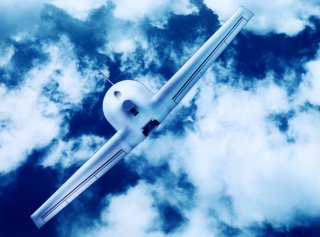RQ-3: The U.S. Air Force’s First Stealth Drone Crashed and Burned
The program was ended because of the cost but also due to aerodynamic stability problems.
Here’s What You Need to Remember: Weighing a beefy 8,500 pounds, the RQ-3 DarkStar was powered by a Williams-Rolls FJ44-1A engine that offered a takeoff thrust of 1,900 pounds. It provided a cruising speed of 288 mph and a service ceiling of 45,000 feet. A total of four were built, including the first prototype that crashed.
Last year, the United States Air Force announced that it would cut the fleet of its Global Hawk spy drones, likely as it was opting to adopt the stealthy RQ-180, a stealthy, flying-wing surveillance drone that reportedly entered service back in 2017. The service has never officially acknowledged the existence of the Northrop Grumman-produced RQ-180, which is believed to have first flown in 2010, and which may have been deployed near China in September 2020.
However, while a few details are known about the flying wing platform, it isn’t the first stealth drone employed by the Air Force.
A DarkStar is Born
Nearly twenty five years ago the RQ-3 DarkStar took its first flight, but a year later the first prototype crashed during its second flight and not in the “going down in a blaze of glory” kind of way. It was more of a suggestion that the bugs had to be worked on the highly-advanced, stealthy reconnaissance remotely piloted aircraft (RPA).
Developed under the Advanced Airborne Reconnaissance System (AARS) program, the RQ-3 was designed to operate in high-threat environments, the aircraft incorporated stealth aircraft technology that could allow it operate within highly defended airspace.
That was in contrast to the RQ-4 Global Hawk, which could only operate in airspace where the United States essentially had air supremacy.
A second prototype was constructed and took part in a total of five flights beginning in mid-1998 before the program was cancelled a year later just prior to an airworthiness test flight.
An Autonomous Spy Plane
The DarkStar was also notable in that it was a fully autonomous platform that could take off, fly to its target, operate its sensors, transmit information, return and land without any human intervention.
By utilizing digital links to transmit sensor images, DarkStar could also provide timely information across the globe—and if needed, ground station operators could still take control of the RPA from anywhere in the world using satellite links. It had a reported 575 mile range, and a flight time of eight hours.
More Wing, Less Star
Unlike the unmanned aerial vehicles (UAVs) developed at the time, the DarkStar is noted for its disc-like fuselage, which was well-contoured and quite squat in its general profile. It featured straight-wing appendages with a wingspan of sixty-nine feet in length and a height of three feet, six inches.
Weighing a beefy 8,500 pounds, the RQ-3 DarkStar was powered by a Williams-Rolls FJ44-1A engine that offered a takeoff thrust of 1,900 pounds. It provided a cruising speed of 288 mph and a service ceiling of 45,000 feet.
A total of four were built, including the first prototype that crashed. The program was ended because of the cost but also due to aerodynamic stability problems. While a unique autonomous drone, the DarkStar could be a testament of the unmanned systems to come rather than a failure.
All three of the surviving prototypes are now housed in various aviation museums including the National Museum of the United States Air Force at Wright-Patterson Air Force Base in Dayton, Ohio; and the Museum of Flight in Seattle; while the fourth prototype, which never flew, is currently held in the Smithsonian National Air and Space Museum in Washington, D.C., but is not currently on display.
Peter Suciu is a Michigan-based writer who has contributed to more than four dozen magazines, newspapers and websites. He regularly writes about military small arms, and is the author of several books on military headgear including A Gallery of Military Headdress, which is available on Amazon.com.
This article is being republished due to reader interest.
Image: Reuters.

